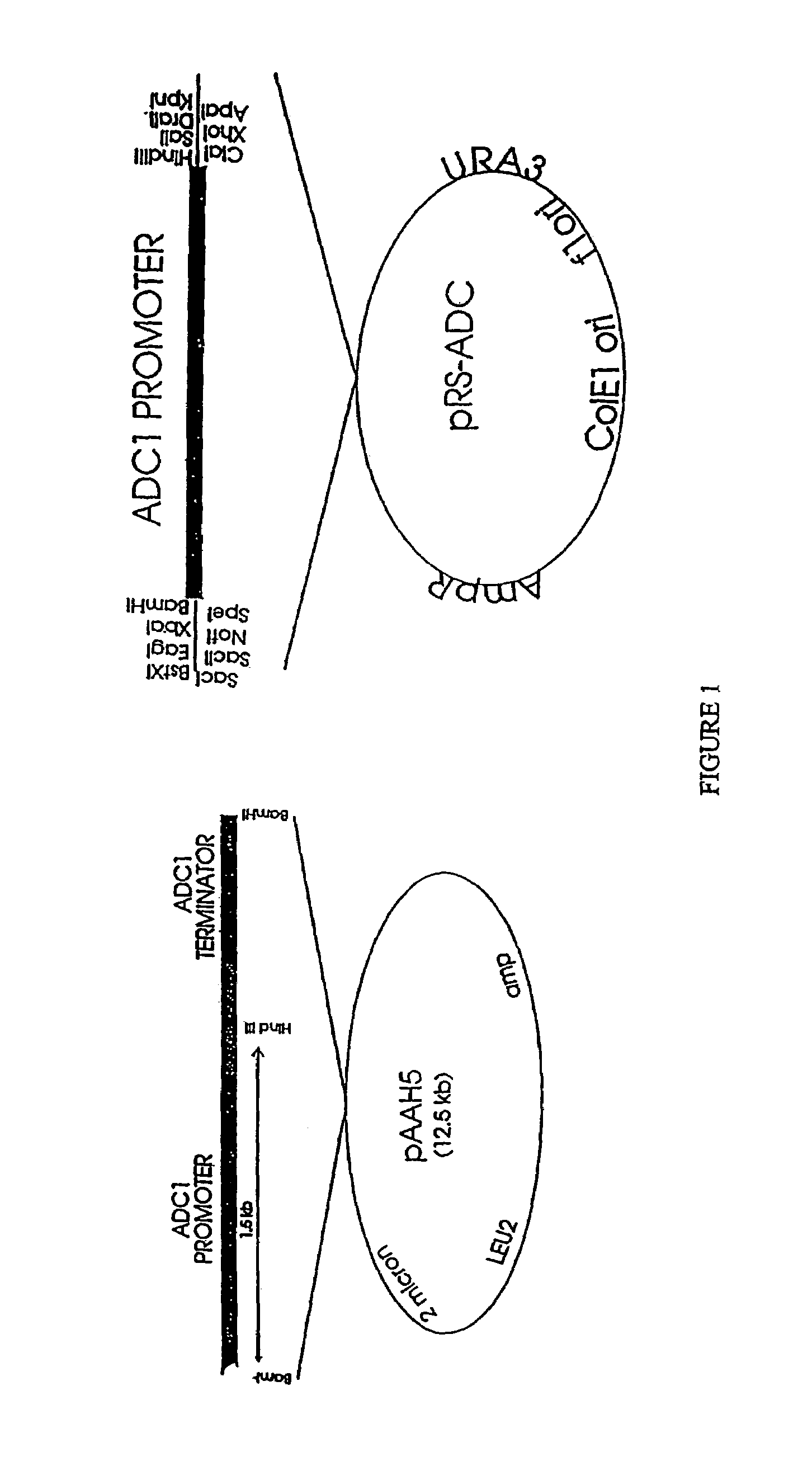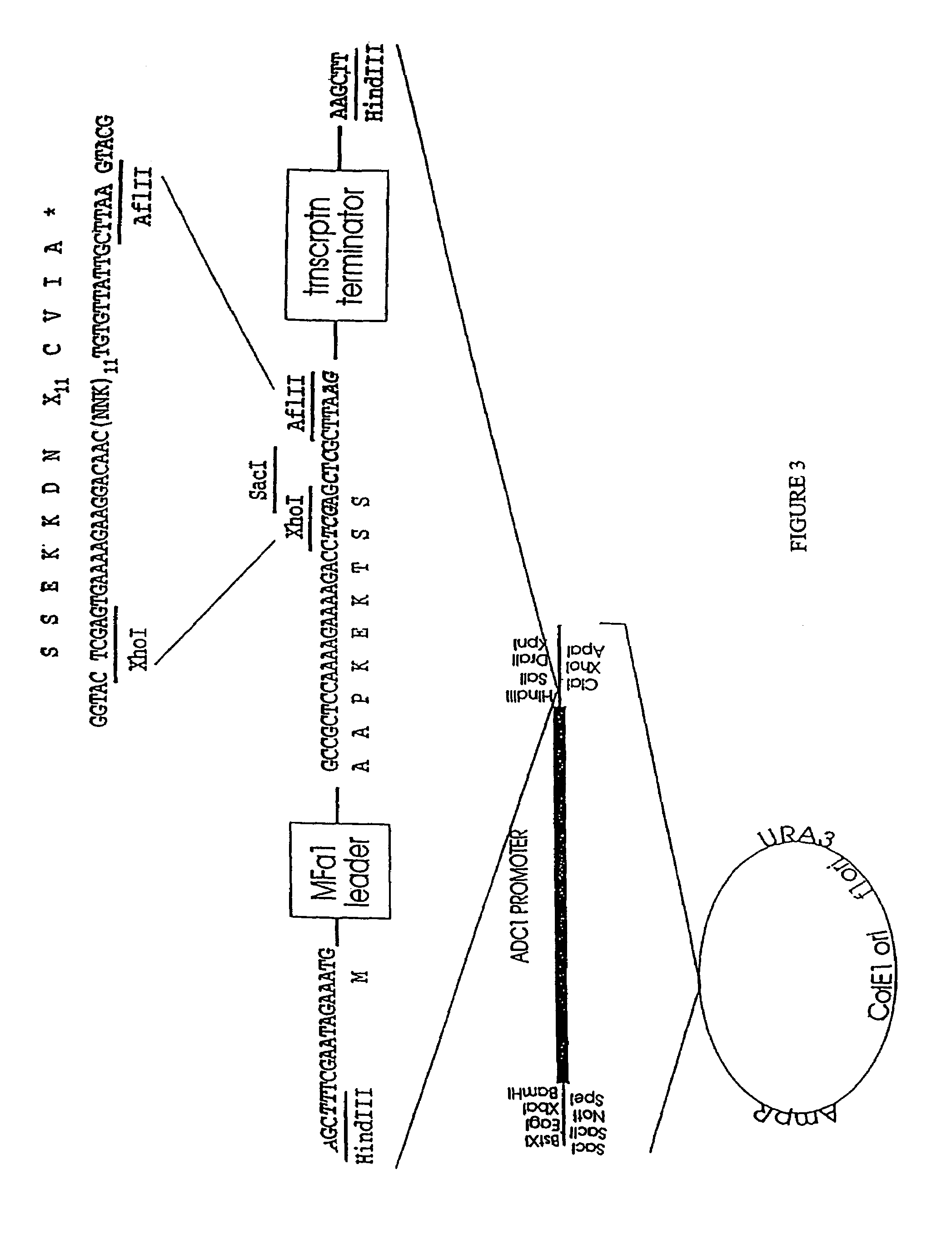Methods and compositions for identifying receptor effectors
a receptor and effector technology, applied in the field of methods and compositions for identifying receptor effectors, can solve the problems of inherently inefficient, limited biological response, and difficult elucidation of the function of these orphan receptors, and achieve the effect of rapid, reliable and effective screening assays
- Summary
- Abstract
- Description
- Claims
- Application Information
AI Technical Summary
Benefits of technology
Problems solved by technology
Method used
Image
Examples
example 1
Development of Autocrine Yeast Strains
[0300]This example describes a pilot experiment in which haploid cells were engineered to be responsive to their own pheromones. (Note that in the examples, functional genes are capitalized and inactivated genes are in lower case.) For this purpose, recombinant DNA molecules designed, and constructed, to:
[0301]i. place the coding region of STE2 under the transcriptional control of elements which normally direct the transcription of STE3. This is done in a plasmid that allows the replacement of genomic STE3 of S. cerevisiae with sequences wherein the coding sequence of STE2 is driven by STE3 transcriptional control elements; and
[0302]ii. place the coding region of STE3 under the transcriptional control of elements which normally direct the transcription of STE2. This is done in a plasmid which will allow the replacement of genomic STE2 of S. cerevisiae with sequences wherein the coding sequence of STE3 is driven by STE2 transcriptional control el...
example 2
Strain Development
[0313]In this example, yeast strains are constructed which will facilitate selection of clones which exhibit autocrine activation of the pheromone response pathway. To construct appropriate yeast strains, we will use: The YIp-STE3 and pRS-STE2 knockout plasmids described above, plasmids available for the knockout of FAR1, SST2, and HIS3, and mutant strains that are commonly available in the research community. The following haploid strains will be constructed, using one-step or two-step knockout protocols described in Meth. Enzymol 194:281-301, 1991:
[0314]
1.MATαste3::STE2::ste3far1sst2FUS1::HIS32.MATαste2::STE3::ste2far1sst2FUS1::HIS33.MATαste3::STE2::ste3far1sst2mfα1 mfα2FUS1::HIS34.MATaste2::STE3::ste2far1sst2mfa1 mfa2FUS1::HIS35.MATabar1far1-1fus1-HIS3ste14::TRP1ura3trp1leu2his36.MATamfa1mfa2far1-1his3::fus1-HIS3ste2-STE3ura3met1ade1leu2
[0315]Strains 1 and 2 will be tested for their ability to grow on histidine-deficient media as a result of autocrine stimulatio...
example 3
[0316]In this example, a synthetic oligonucleotide encoding a peptide is expressed so that the peptide is secreted or transported into the periplasm.
[0317]i. The region of MFα1 which encodes mature α-factor has been replaced via single-stranded mutagenesis with restriction sites that can accept oligonucleotides with AflII and BglII ends. Insertion of oligonucleotides with AflII and BglII ends will yield plasmids which encode proteins containing the MFα1 signal and leader sequences upstream of the sequence encoded by the oligonucleotides. The MFα1 signal and leader sequences should direct the processing of these precursor proteins through the pathway normally used for the transport of mature α-factor.
[0318]The MFα1 gene, obtained as a 1.8 kb EcoRI fragment from pDA6300 (J. Thorner, Univ. of California) was cloned into pALTER in preparation for oligonucleotide-directed mutagenesis to remove the coding region of mature α-factor while constructing sites for acceptance of ...
PUM
| Property | Measurement | Unit |
|---|---|---|
| pH | aaaaa | aaaaa |
| α factor | aaaaa | aaaaa |
| nucleic acid hybridization technology | aaaaa | aaaaa |
Abstract
Description
Claims
Application Information
 Login to View More
Login to View More - R&D
- Intellectual Property
- Life Sciences
- Materials
- Tech Scout
- Unparalleled Data Quality
- Higher Quality Content
- 60% Fewer Hallucinations
Browse by: Latest US Patents, China's latest patents, Technical Efficacy Thesaurus, Application Domain, Technology Topic, Popular Technical Reports.
© 2025 PatSnap. All rights reserved.Legal|Privacy policy|Modern Slavery Act Transparency Statement|Sitemap|About US| Contact US: help@patsnap.com



